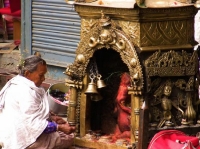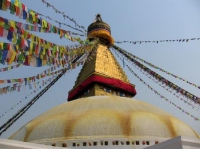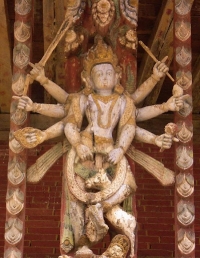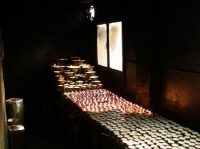The ancient Ayurvedic scholars analyzed all known physical and mental diseases one by one. In doing so, they discovered that there are certain diseases that do not follow the theory of balance of the three bodily substances. These diseases were classified into three groups:
- Mental diseases caused by the Bhuta (invisible atmospheric personalities).
- Children’s diseases caused by the Graha.
- Diseases that are caused partly by the Bhuta and partly by lack of balance in Vata, Pitta and Kapha.
 The ancient way of identifying spiritual diseases was based upon the observation that the sudden emergence of drastic symptoms could sometimes occur prior to morbid changes in anatomy. This is the reverse of the usual process where physiological changes precede the onset of symptoms. It was further found that in such cases the regular medicines based on the Tridosha Siddhanta could not be prescribed because they actually could cause a worsening of the symptoms. In such critical situations, the use of spiritual treatments was found to be beneficial to control this sort of disease, at least to some extent. These spiritual treatments can be broken down into five categories, related to the five sense organs:
The ancient way of identifying spiritual diseases was based upon the observation that the sudden emergence of drastic symptoms could sometimes occur prior to morbid changes in anatomy. This is the reverse of the usual process where physiological changes precede the onset of symptoms. It was further found that in such cases the regular medicines based on the Tridosha Siddhanta could not be prescribed because they actually could cause a worsening of the symptoms. In such critical situations, the use of spiritual treatments was found to be beneficial to control this sort of disease, at least to some extent. These spiritual treatments can be broken down into five categories, related to the five sense organs:
- Sound therapy
- Figure therapy
- Odor therapy
- Taste therapy
- Contact therapy
Mental Diseases Caused by the Bhuta
 Mental diseases caused by the Bhuta are called Bhutonmada or Agantuja-unmada. In these cases, a powerful change of personalities is the main symptom. These kinds of mental diseases with change of personality are not the result of the aggravating agents of Vata, Pitta and Kapha. All the bodily systems function with normal coordination. However, the operation of the mind becomes monotonously and persistently obsessed by unusual or extraordinary memories that appear to enter into the thought processes from outside the person’s normal life experience. These unusual memories result in a complete change of personality and sometimes develop into extraordinary personalities or entities that seem to inhabit the affected person. The Sanskrit word Bhuta is used to define these unseen biological entities. They manifest in humans as typical sorts of characters. The unseen mental personality or Bhuta has both a negative and a positive side. Bhuta in the negative sense can be the cause of certain diseases that do not follow the theory of balance. But the Bhuta in a positive sense can be a remedy for the same diseases. This is a well-investigated fact in the field of Ayurvedic spiritual healing. Concerning to the treatment of the mental diseases with the change of personalities, Ayurveda presents the symbolic groups of characters known as Deva, Rishi, Pitri, Gandharva, Yaksha, Rakshasa and Pishacha. These words are synonyms for different types of Bhutas that represent the typical roles played by the unseen biological personalities. It is thought that these biological forces are active in the atmosphere, in spite of the fact that no one can see them with their naked eyes. These invisible entities are not in general harmful to human beings. But when people violate the disciplines of human society–breaking the social rules and regulations–the Bhutas can bring harm by causing mental disorders and some physical diseases. This is the Ayurvedic understanding of Bhuta in relationship to medical practice.
Mental diseases caused by the Bhuta are called Bhutonmada or Agantuja-unmada. In these cases, a powerful change of personalities is the main symptom. These kinds of mental diseases with change of personality are not the result of the aggravating agents of Vata, Pitta and Kapha. All the bodily systems function with normal coordination. However, the operation of the mind becomes monotonously and persistently obsessed by unusual or extraordinary memories that appear to enter into the thought processes from outside the person’s normal life experience. These unusual memories result in a complete change of personality and sometimes develop into extraordinary personalities or entities that seem to inhabit the affected person. The Sanskrit word Bhuta is used to define these unseen biological entities. They manifest in humans as typical sorts of characters. The unseen mental personality or Bhuta has both a negative and a positive side. Bhuta in the negative sense can be the cause of certain diseases that do not follow the theory of balance. But the Bhuta in a positive sense can be a remedy for the same diseases. This is a well-investigated fact in the field of Ayurvedic spiritual healing. Concerning to the treatment of the mental diseases with the change of personalities, Ayurveda presents the symbolic groups of characters known as Deva, Rishi, Pitri, Gandharva, Yaksha, Rakshasa and Pishacha. These words are synonyms for different types of Bhutas that represent the typical roles played by the unseen biological personalities. It is thought that these biological forces are active in the atmosphere, in spite of the fact that no one can see them with their naked eyes. These invisible entities are not in general harmful to human beings. But when people violate the disciplines of human society–breaking the social rules and regulations–the Bhutas can bring harm by causing mental disorders and some physical diseases. This is the Ayurvedic understanding of Bhuta in relationship to medical practice.
Children’s Diseases caused by the Graha
Children’s diseases caused by the Graha are called Bala-graha. The word Graha is similar to the word Bhuta, but the Grahas only affect children. For treatment of children’s diseases caused by the Grahas, Ayurveda utilities the symbolic characters known as Skanda, Skandapasmara, Shakuni, Revati, Putana, Andhaputana, Shitaputana, Mukhamandika, and Naigameya. These words are synonyms for various sorts of Grahas that have individual roles to play as unseen biological forces. Grahas can, without any prior bodily imbalances, cause children to all of a sudden develop serious symptoms of gastro-intestinal diseases accompanied by great fear and alternations in perception. The Grahas are usually not as harmful as the Bhutas. However, under conditions of poor sanitation or violation of social disciplines and rules, they can enter the mind and cause many complicated children diseases. These are diseases that cannot be cured using the principles of bodily balance.
Additional Diseases Caused by the Bhuta
There are some other diseases that involve both the Bhuta as well as the theory of balance. These are classified into a group of diseases that all of a sudden develop symptoms prior to morbid anatomical changes. For any disease to have real symptoms there first of all should be early imbalances or minor anatomical changes that cause early physical and/or mental signs or symptoms. After this preliminary stage the real symptoms of the particular disease appear to signify the existence of diseased anatomy. This is a general rule of the disease process. The Bhuta cause diseases where the symptoms appear first, and then anatomical changes take place. They are not initially caused by imbalances in the primary substances. Severe disease in patients with no signs of imbalance, such as the sudden symptoms that occur in malaria, poor diet or poor lifestyle, are included in this group.
Sound Therapy
 Sound therapy is called Mantra chikitsa. It is related to the sense of hearing. Well-known mantras include those named Swastivachana, Mangalacharana, Dharani etc. Mantras are composed of selected vowels and consonants. Vowels and consonants joins together to form words and all words have symbolic meaning. Meanings associated with words are used by the mind in order to function. The Swastivachana, Mangalacharana and Dharani etc. are compositions of auspicious words, i.e. words with religious significance. Mangalacharana is the auspicious chanting done to start or begin any kind of holy worship, or to start a new project to begin. Its purpose is to produce a positive result. For example, if someone is beginning a new work or preparing to travel, Mangalacharana is chanted to create a positive result. Swastivachana is more or less the same but is more inclined towards (1) reducing the chances that bad events will occur, (2) to protect from evil, or (3) to remove psychological problems such as fear or confusion. Mantras are pronounced with silent vocalization, and Dharanis are chanted out loud with melodious vocalization. It is clear that meaningful sounds, whether pronounced in silence or out loud, have a direct effect on the operation of the mind. Positive sounds stimulate the mind via the sense organs to connect with the body. Mind-body connection is very important for physical and mental health. Negative sounds mislead the mind, disturbing both mind and body. Positive sounds in general are pronounced with an emphasis on the consonants, and the negative sounds are pronounced projecting with an emphasis on the vowels. Based upon this consideration, Mantras and Dharanis are composed emphasizing various unique methods of projecting the sounds of either vowels or consonants to create specific effects. Mantra therapy is part of the Ayurvedic spiritual healing branch. There are many Mantras and Dharanis composed by different saints (Rishis and Munis). Individual Mantras are usually associated with specific religious groups. Religion is the discipline that seeks to find the reality of the universe beyond the physical. Without such discipline it is not possible to concentrate one’s mind enough to understand universal truths. The recitation of Mantras or Dharanis is one of the most important of the religious disciplines. It is well experienced that this discipline is a very powerful method for concentrating the mind in a positive way, and mental concentration is very beneficial to health. Mantras developed for treatment are written down in both the religious texts and the Ayurvedic spiritual healing texts. Anyone can read and recite them, but their effect depends upon the “mental confidence” of the recipient. This “confidence” is defined by the Sanskrit word Siddhi. Siddhi is synonymous with the highest stage of confidence and mental focus attainable by a human being. The person who has Siddhi can strongly focus his mind and mobilize his desires. Some persons with Siddhi can recite Mantras and induce a patient’s disturbed mind and body to return to normal. That is, a person whose mind and body are functioning in this concentrated way can fix his attention on another person’s disturbed mind and/or body, and impact it with the vibrations emanating from his pure mind or from his voice. The vibration of mind means here the positive intention to correct the other persons disturbed mind and/or body. This is the basic principle of the sound therapy called Mantra- Chikitsa.
Sound therapy is called Mantra chikitsa. It is related to the sense of hearing. Well-known mantras include those named Swastivachana, Mangalacharana, Dharani etc. Mantras are composed of selected vowels and consonants. Vowels and consonants joins together to form words and all words have symbolic meaning. Meanings associated with words are used by the mind in order to function. The Swastivachana, Mangalacharana and Dharani etc. are compositions of auspicious words, i.e. words with religious significance. Mangalacharana is the auspicious chanting done to start or begin any kind of holy worship, or to start a new project to begin. Its purpose is to produce a positive result. For example, if someone is beginning a new work or preparing to travel, Mangalacharana is chanted to create a positive result. Swastivachana is more or less the same but is more inclined towards (1) reducing the chances that bad events will occur, (2) to protect from evil, or (3) to remove psychological problems such as fear or confusion. Mantras are pronounced with silent vocalization, and Dharanis are chanted out loud with melodious vocalization. It is clear that meaningful sounds, whether pronounced in silence or out loud, have a direct effect on the operation of the mind. Positive sounds stimulate the mind via the sense organs to connect with the body. Mind-body connection is very important for physical and mental health. Negative sounds mislead the mind, disturbing both mind and body. Positive sounds in general are pronounced with an emphasis on the consonants, and the negative sounds are pronounced projecting with an emphasis on the vowels. Based upon this consideration, Mantras and Dharanis are composed emphasizing various unique methods of projecting the sounds of either vowels or consonants to create specific effects. Mantra therapy is part of the Ayurvedic spiritual healing branch. There are many Mantras and Dharanis composed by different saints (Rishis and Munis). Individual Mantras are usually associated with specific religious groups. Religion is the discipline that seeks to find the reality of the universe beyond the physical. Without such discipline it is not possible to concentrate one’s mind enough to understand universal truths. The recitation of Mantras or Dharanis is one of the most important of the religious disciplines. It is well experienced that this discipline is a very powerful method for concentrating the mind in a positive way, and mental concentration is very beneficial to health. Mantras developed for treatment are written down in both the religious texts and the Ayurvedic spiritual healing texts. Anyone can read and recite them, but their effect depends upon the “mental confidence” of the recipient. This “confidence” is defined by the Sanskrit word Siddhi. Siddhi is synonymous with the highest stage of confidence and mental focus attainable by a human being. The person who has Siddhi can strongly focus his mind and mobilize his desires. Some persons with Siddhi can recite Mantras and induce a patient’s disturbed mind and body to return to normal. That is, a person whose mind and body are functioning in this concentrated way can fix his attention on another person’s disturbed mind and/or body, and impact it with the vibrations emanating from his pure mind or from his voice. The vibration of mind means here the positive intention to correct the other persons disturbed mind and/or body. This is the basic principle of the sound therapy called Mantra- Chikitsa.
Figure Therapy
 Figure therapy is called Rupachikitsa or Murtichikitsa. It is related to vision. Rupa means figure. All figures have form and color. Use of (1) colorful figures of deities, (2) Mandala diagrams, and (3) focus upon the personality of spiritual persons are the major methods of figure therapy. These figures play a major role in impressing the disturbed mind and body in a positive way. Extraordinary drawn or carved figures of deities that are symbols of a deeper spiritual reality, can positively affect a disturbed mind. They can draw the mind back to civility. The civil or polite mind is one with a restored sense of right and wrong. In the same way, the colorful diagrams known as Mandalas, considered to be abodes of God, can similarly affect a disturbed mind and body to return to normal activity. There is power in the personality of persons who have accomplished spiritual mastery, great learning, sports ability or financial achievement. The mental powers of such persons can be an aid to bringing the wayward mind back under control. A strong mind naturally holds away over a weak one. A stronger personality can handle the mind of a weaker one, because the weaker mind becomes considerate and polite in the presence of an acknowledged superior. Accomplished spiritual healers and priests therefore play a major role in the practice of figure therapy. In practice figure therapy involves ritual practices and worship under the guidance of a priest or spiritual healer.
Figure therapy is called Rupachikitsa or Murtichikitsa. It is related to vision. Rupa means figure. All figures have form and color. Use of (1) colorful figures of deities, (2) Mandala diagrams, and (3) focus upon the personality of spiritual persons are the major methods of figure therapy. These figures play a major role in impressing the disturbed mind and body in a positive way. Extraordinary drawn or carved figures of deities that are symbols of a deeper spiritual reality, can positively affect a disturbed mind. They can draw the mind back to civility. The civil or polite mind is one with a restored sense of right and wrong. In the same way, the colorful diagrams known as Mandalas, considered to be abodes of God, can similarly affect a disturbed mind and body to return to normal activity. There is power in the personality of persons who have accomplished spiritual mastery, great learning, sports ability or financial achievement. The mental powers of such persons can be an aid to bringing the wayward mind back under control. A strong mind naturally holds away over a weak one. A stronger personality can handle the mind of a weaker one, because the weaker mind becomes considerate and polite in the presence of an acknowledged superior. Accomplished spiritual healers and priests therefore play a major role in the practice of figure therapy. In practice figure therapy involves ritual practices and worship under the guidance of a priest or spiritual healer.
Odor Therapy
Odor therapy is called Gandha chikitsa. It is related to the sense of smell. For this type of therapy, many kinds of incense are made from medicinal plants, animal products and minerals. The nose is considered by Ayurveda to be a direct passageway to the brain that in turn is connected with all the sense organs. Incense has a direct effect on the brain. The disturbed mind can be “awakened to reality” by the smell of incense. That is, Ayurvedic investigations have discovered certain types of incense that have extraordinary powers to awaken and draw the disturbed mind back to reality. Only a mind awakened to reality can distinguish right from wrong. In addition to this general concept, another valuable aspect of the odor therapy is concerned with the negative effect of a polluted atmosphere. Polluted air is the cause of many physical and mental diseases. Ayurveda has clearly pointed out that the disease-causing effects of air pollution are related to a defilement of Bhutas and Grahas. Although the naked eye cannot see defilement caused by the Bhutas and Grahas, they can nonetheless bring harm to human beings. The use of incense that quickly spreads through the atmosphere, has been found to be very effective in clearing out the defilement caused by Bhutas and Grahas. This kind of medical incense, made from very specific herbs, has two effects. First it cleans the atmosphere dissipating pollution. Secondly, it also helps to cleanse the body when we inhale, because inhaling incense can stimulate the blood to clean out pollutants. Smelling incense also affects the mind by stimulating its positive functions. On the other hand, the negative effects of air pollution make the body more susceptible to Bhutas and Grahas. That is, according to Ayurveda, serious air pollution can induce insanity. Another simple treatment for this is to use anti-epilepsy medicines internally, such as the powders of Vacha rhizome (acorus / Acorus calamus), Brahmi leaf/root (gotu kola / Hydrocotyle asiatica /Centella asiatica) and Shatavari root (asparagus / Asparagus racemosus).
Taste Therapy
 Taste therapy is called Rasa chikitsa. It is related to the sense of taste. Rasa chikitsa is also known by the term Bali. Bali means food that is offered to a god. Special foods are prepared to tempt the desire of the patient, who then offers it to their favorite god as Bali. It is noted that the disturbed mind, if it can resist the temptation to eat the Bali, can get back to its normal sense. This demonstration is very important to fix the disturbed mind and get it to focus on something positive. This is the general concept of taste therapy. Besides this general concept, the most interesting aspect of Bali is concerned with the biological functions of the Bhutas and Grahas. It is well investigated that different Bhuta and Graha prefer particular foods that they need to survive. It is believed that when a particular food desired by a Bhutas or a Graha is presented to tempt a patient, they will attempt to control the patient’s mind and get him to eat it. The moment when a Bhuta or a Graha is concentrated to get the food (Bali) is a very practical time to drive them out. Therefore, in taste therapy, the Bali tempts the patient, but instead of eating it he offers it to his god. After the Bali is offered to the god in ceremony, it is thrown way in a restricted area such as the bank of river, a cemetery grounds, or a crossroads. Bali that has been offered to a god is not allowed to be eaten by anyone, because it now contains Bhutas or Grahas. Bali is also used to mean the practice of animal sacrifice, concerned with killing the unseen Bhuta. In this practice, a spiritual healer who is devoted to wrathful deities (a type of god) performs a ritual ceremony in which an animal or bird is killed. The chosen animal or bird is transformed into a biological form for the Bhuta to enter, drawn in by the inner mental power of the ritual meditation. The animal or the bird is not considered any longer to be an ordinary animal or bird. It has been ritually transformed into a living being inhabited by the Bhuta. The operation of sacrificing the creature is believed to be a spiritual way of killing the Bhuta that has caused the physical or mental problems of the patient. It is the experience of Ayurvedic spiritual healers of the past that this method of killing Bhuta in the form of an animal or bird can eliminate certain types of mental and physical problems. These reports are very interesting. However, they seem very ignorant today.
Taste therapy is called Rasa chikitsa. It is related to the sense of taste. Rasa chikitsa is also known by the term Bali. Bali means food that is offered to a god. Special foods are prepared to tempt the desire of the patient, who then offers it to their favorite god as Bali. It is noted that the disturbed mind, if it can resist the temptation to eat the Bali, can get back to its normal sense. This demonstration is very important to fix the disturbed mind and get it to focus on something positive. This is the general concept of taste therapy. Besides this general concept, the most interesting aspect of Bali is concerned with the biological functions of the Bhutas and Grahas. It is well investigated that different Bhuta and Graha prefer particular foods that they need to survive. It is believed that when a particular food desired by a Bhutas or a Graha is presented to tempt a patient, they will attempt to control the patient’s mind and get him to eat it. The moment when a Bhuta or a Graha is concentrated to get the food (Bali) is a very practical time to drive them out. Therefore, in taste therapy, the Bali tempts the patient, but instead of eating it he offers it to his god. After the Bali is offered to the god in ceremony, it is thrown way in a restricted area such as the bank of river, a cemetery grounds, or a crossroads. Bali that has been offered to a god is not allowed to be eaten by anyone, because it now contains Bhutas or Grahas. Bali is also used to mean the practice of animal sacrifice, concerned with killing the unseen Bhuta. In this practice, a spiritual healer who is devoted to wrathful deities (a type of god) performs a ritual ceremony in which an animal or bird is killed. The chosen animal or bird is transformed into a biological form for the Bhuta to enter, drawn in by the inner mental power of the ritual meditation. The animal or the bird is not considered any longer to be an ordinary animal or bird. It has been ritually transformed into a living being inhabited by the Bhuta. The operation of sacrificing the creature is believed to be a spiritual way of killing the Bhuta that has caused the physical or mental problems of the patient. It is the experience of Ayurvedic spiritual healers of the past that this method of killing Bhuta in the form of an animal or bird can eliminate certain types of mental and physical problems. These reports are very interesting. However, they seem very ignorant today.
Contact Therapy
Contact therapy is called Sparsha- chikitsa. It is concerned with the sense of touch. In this subject, various types of jewels as well as unique animal products, minerals or plants are used. These objects were found by Ayurvedic physicians to have the power to relieve mental and physical problems caused by Bhutas or Grahas. These jewels are considered to have miraculous powers called Mani or Divyousadhi are given to a patient to handle. The sense of touch is the foundation of the five sense organs, because without touch or contact no sense organ can perceive. However, perception also requires the understanding provided by the mental faculties. Ayurvedic doctors discovered that the contact with those Mani with unique powers could result in a disturbed mind and body returning to normal activity. The spiritual healers also found that the effect of the Mani did not operate according the laws of Tridosha. Therefore they classified the actions as due to Divinity, because no one understood why and how they worked. There are many stories and legends in the Ayurvedic literature about the miraculous effects of Mani. To this day there are some spiritual healers who claim to have powerful Mani passed down to them from generation to generation.
0 Responses to “Theory of Spiritual Healing”